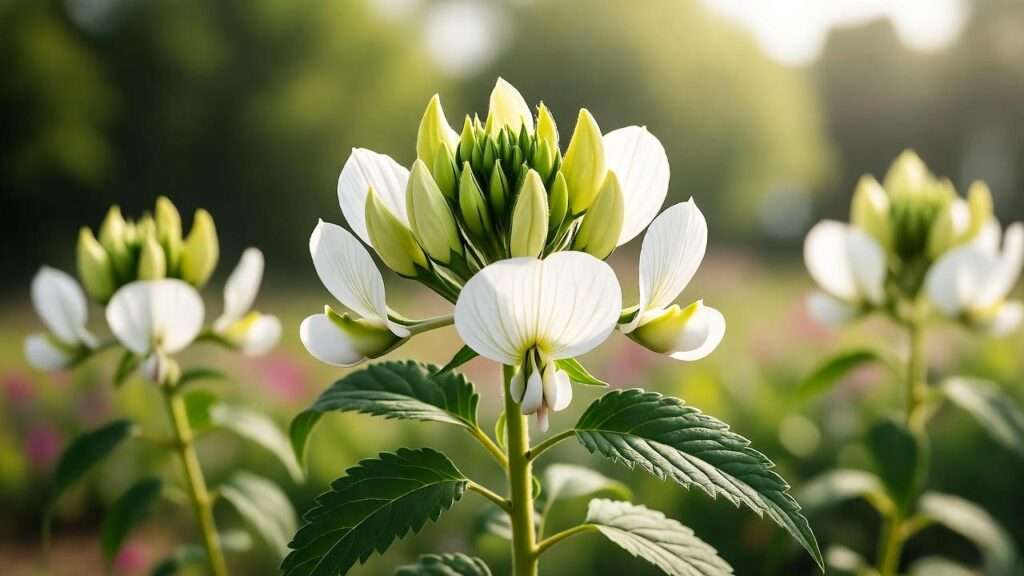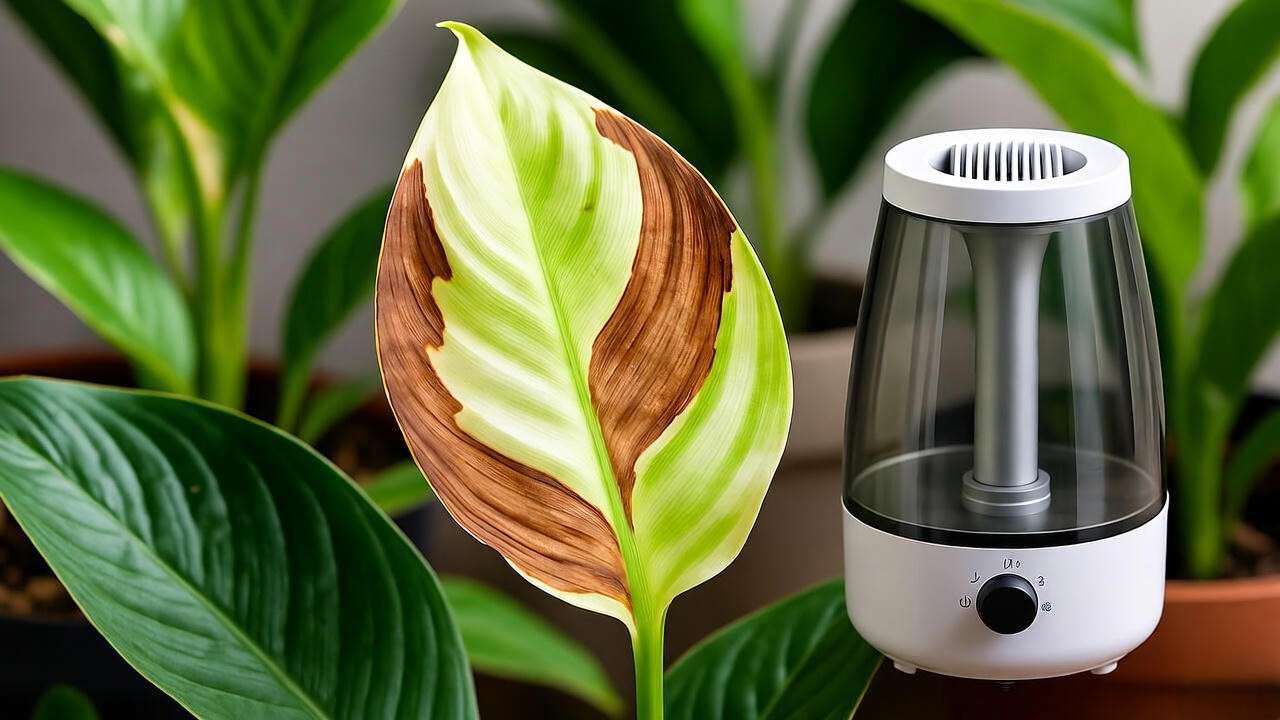The White Butterfly Plant—also known as the Arrowhead Plant—is the houseplant equivalent of a stylish, low-maintenance friend. You bring it home, captivated by its delicate green and creamy white variegation, expecting effortless tropical beauty.
But then, the disappointment sets in. Maybe its leaves turn alarmingly crispy and brown. Perhaps it’s become a sparse, spindly vine reaching desperately for the light. If you’ve ever felt the frustration of watching your Syngonium struggle, you are not alone. This is the hidden frustration of a plant that is easy to care for only if you understand its specific needs.
As plant care experts, we know the difference between a struggling plant and a thriving one often comes down to just one or two missed steps. The core intent of this essential guide is to eliminate the guesswork and provide you with the comprehensive knowledge needed to ensure your White Butterfly Plant (scientifically known as Syngonium podophyllum ‘White Butterfly’) is lush, full, and vibrant all year round.
We guarantee that by the end of this article, you will have the expert-level care routines and foolproof troubleshooting strategies to stop the struggle and watch your plant flourish. 🌱
II. Getting to Know Your White Butterfly Plant: Fundamentals & Facts 🧐
To truly excel at plant care, you must first understand the plant’s nature and origins. This insight provides the foundation for why we recommend specific light, soil, and humidity levels.
A. Proper Identification (E-E-A-T Foundation)
The exact focus of this guide is:
- Scientific Name: Syngonium podophyllum
- Cultivar: ‘White Butterfly’
- Common Aliases: Arrowhead Plant, Arrowhead Vine, Goosefoot Plant (due to the shape of its leaves).
The White Butterfly cultivar is particularly popular because of its striking, pale green and creamy-white foliage. This variegation is what makes its care slightly different from its purely green cousins, especially regarding light exposure.
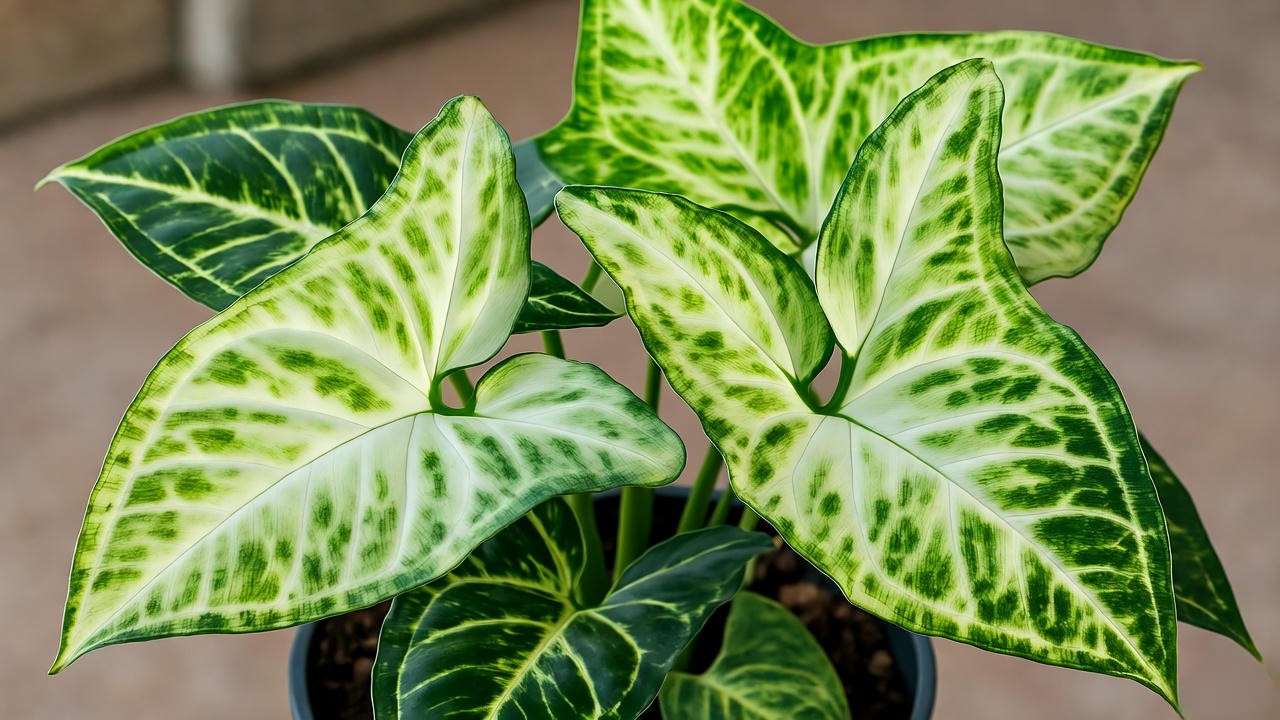
B. Native Habitat & Growth Habit
Originating in the tropical rainforests of Central and South America, the Syngonium podophyllum is naturally an understory plant.
- Understory Life: In the wild, it grows beneath the canopy of large trees, meaning it receives filtered, bright, indirect light—a crucial clue for its ideal indoor placement.
- Growth Habit: It starts as a compact, bushy plant (the juvenile form) but, with time, develops a trailing or climbing habit (the mature form), using aerial roots to cling to trees. This tells us it appreciates a vertical support structure indoors.
C. Key Aesthetics: Why People Love the ‘White Butterfly’
The appeal is undeniable:
- Signature Leaf Shape: The leaves transition from simple, heart-shaped forms when young to the iconic three-lobed (arrowhead) shape as the plant matures.
- The Variegation Factor: The striking, large patches of creamy white and pale green are the main draw. This coloration, however, is delicate and is the first thing to suffer if the plant’s light conditions aren’t perfect.
III. The Core Five: Essential White Butterfly Plant Care Requirements 💧💡🪴
Mastering these five fundamental elements is the key to preventing the vast majority of problems. Think of this as the Syngonium Golden Rulebook.
A. Optimal Lighting Requirements 💡
Getting light right is arguably the single most important factor, especially for a variegated plant.
H3: The Sweet Spot: Bright, Indirect Light is Best.
Since it’s an understory plant, the White Butterfly Plant thrives when placed near an east-facing window (morning sun) or a few feet away from a south or west-facing window (intense afternoon sun). The light should be bright enough to cast a soft, diffused shadow, but never direct.
H3: Danger Zone: Understanding Sunburn vs. Insufficient Light
- Too Much Light (Direct Sun): The white sections of the leaves are sensitive and will easily develop brown, scorched, or crispy patches—a sign of sunburn.
- Too Little Light: The plant will quickly become leggy (long, sparse stems with few leaves). Crucially, the beautiful white variegation will begin to fade, and the new growth will be predominantly green as the plant desperately tries to produce more chlorophyll to survive.

H3: Rotation Tips: Why & How to Rotate Your Plant for Even Growth
Because Syngonium leaves tend to orient themselves toward the light source, you should rotate your pot 90 degrees every week to encourage even, bushy growth and prevent one side from becoming sparse.
B. Watering Needs and Strategies 💦
Overwatering is the number one cause of Syngonium death. Learn the “when” before the “how much.”
H3: The “Finger Test” Method: When to Water (The 2-3 Inch Rule)
Wait until the top 2 to 3 inches of the soil are completely dry before watering. Stick your finger into the soil. If it comes out dry, it’s time. If you feel any lingering moisture, wait another day or two.
H3: Why Overwatering is the #1 Killer (Root Rot Prevention)
When soil stays consistently wet, the roots are starved of oxygen and begin to rot. Root rot symptoms often mimic underwatering (droopy, yellow leaves), which leads panicked beginners to water more, tragically accelerating the problem. Ensure your pot has excellent drainage.
H3: Seasonal Adjustments (Dormancy in Winter vs. Active Growth in Summer)
Your plant’s need for water dramatically decreases during the cooler, darker winter months. Slow down your watering frequency, allowing the soil to dry out more deeply between waterings. This respects its natural seasonal dormancy.
C. Soil, Potting, and Drainage Mix 🪴
The soil’s primary job is to provide structural support while simultaneously allowing maximum airflow around the roots.
H3: The Ideal Substrate: Well-Draining, Airy, & Organic-Rich Mix
Avoid heavy, dense potting soil. Your Syngonium needs a mix that retains some moisture but lets excess water drain away instantly.
H3: Expert Tip: The Power of Perlite and Orchid Bark for Syngoniums.
A fantastic, easy mix is: 2 parts standard potting mix, 1 part perlite (or pumice), and 1 part orchid bark/charcoal. The perlite ensures aeration, while the orchid bark prevents the soil from compacting over time.
H3: The Critical Role of Drainage Holes (Why Cachepots are Risky)
Never plant a Syngonium in a pot without a drainage hole. If you use a decorative cachepot (a pot used to conceal the plastic grower pot), always remove the plant to water it completely, let it drain for 15 minutes, and then place it back in the cachepot. Never let it sit in standing water.
D. Temperature, Humidity, & Airflow 🌡️
As a tropical native, the White Butterfly Plant has specific environmental demands that go beyond just water and light.
H3: Maintaining the Tropical Vibe: Ideal Temperature Ranges (Avoid Cold Drafts!)
Aim to keep the air temperature between $60^\circ\text{F}$ and $80^\circ\text{F}$ ($16^\circ\text{C}$ and $27^\circ\text{C}$). Cold drafts from windows, AC vents, or doors are highly damaging and can cause leaf drop or browning overnight.
H3: Humidity Hacks: Misting vs. Pebble Trays vs. Humidifiers.
While Syngoniums can tolerate average home humidity (around $40\%$), they will thrive, and their leaf tips will look better, in $50\%$ to $60\%$ humidity.
- Misting: Provides only temporary, negligible relief and can encourage fungal growth. Skip it.
- Pebble Trays: Can raise localized humidity slightly but requires diligence.
- Electric Humidifiers: The most effective solution, especially in dry winter months, for consistent, high humidity.
H3: Air Circulation: Preventing Mold & Pest Hotspots
Good airflow is essential for minimizing mold growth on the soil surface and discouraging pests like spider mites, which thrive in stale, stagnant conditions.
E. Fertilization Schedule & Type (Feeding for Maximum White)
Fertilizing is how you fuel vigorous, colorful growth.
H3: When and What to Feed: Balanced Liquid Fertilizer during Growing Season
Use a balanced, water-soluble liquid fertilizer (like 10-10-10 or 20-20-20, diluted by half) once a month during the active growing season (spring and summer).
H3: The Importance of Dilution (Avoiding Fertilizer Burn)
Always err on the side of under-fertilizing. Syngoniums are not heavy feeders. Using fertilizer at half strength or less every few weeks is much safer than using full strength and risking fertilizer burn, which presents as crispy, brown leaf tips.
H3: Why You Must Stop Fertilizing in Winter
When the plant’s growth naturally slows down in the fall and winter, stop feeding entirely. Applying fertilizer when the plant is dormant can lead to a damaging buildup of salts in the soil.
IV. Stop the Struggle: Advanced Troubleshooting & Problem Solving 🚨
If your plant is still struggling, this section is your expert diagnostic tool. We’ll address the issues that cause the most headaches for Arrowhead Plant owners.
A. Diagnosing Leaf Issues: Yellow, Brown, & Droopy Foliage 🍂
| Symptom | Appearance | Primary Causes | Expert Solution |
| Yellowing | Leaves (often lower, older ones) turn soft yellow. | Overwatering (The most common cause), lack of nitrogen, or normal leaf senescence. | Allow soil to dry deeper between waterings. Check drainage. If widespread, consider a balanced feed. |
| Brown Edges/Tips | Crispy, dry patches on the outer edges or tips of the leaves. | Low Humidity or Fertilizer Burn/Salt Buildup in the soil. | Increase humidity (humidifier). If chemical, flush the soil with water until it runs clear, then hold off on feeding. |
| Drooping | Leaves and stems appear limp, sad, and deflated. | Underwatering (The most common cause) or advanced root rot. | Test the soil. If dry, water immediately (it should perk up in hours). If wet, suspect root rot and unpot to inspect roots. |
| White Fading to Green | New leaves or existing leaves lose their white variegation and are entirely green. | Insufficient Light (The plant is maximizing chlorophyll production to survive). | Move the plant to a brighter spot immediately. Prune any fully green leaves (see section D). |
B. Correcting Growth Habits: Leggy & Sparse Growth ✂️
H3: The Legginess Culprit: Inadequate Light (and how to fix it immediately)
A leggy Syngonium is desperately telling you it needs more light. The stems stretch out with long spaces between leaves, trying to find a better light source.
- Fix: The immediate solution is to move it to a location with brighter, indirect light.
H3: Pruning for Bushiness: Strategic Cuts to Encourage Branching.
Once the light issue is fixed, you need to prune. Pruning encourages the plant to branch out, creating a fuller, bushier look.
- How to Prune: Simply snip the stem just above a node (the small bump where a leaf or aerial root emerges). This cut releases an auxin hormone, telling the plant to activate the dormant bud below and create a new vine, effectively giving you two branches where there was one.
H3: Climbing vs. Trailing: The Benefits of Using a Moss Pole or Trellis.
Because Syngoniums are natural climbers, giving them a support structure (like a moss pole or bamboo trellis) can drastically improve their health. It allows the plant to mature, often resulting in larger leaves, and encourages a more upright, manageable growth habit.
C. Pest Management: Identifying and Eliminating Common Intruders 🕷️
No plant is immune to pests, but regular inspection is the best defense.
H3: The Big Three: Identification & Lifecycle of Spider Mites, Mealybugs, & Aphids.
- Spider Mites: Look for fine webbing on the undersides of leaves and tiny, yellowish-brown spots. Thrives in dry, low-humidity conditions.
- Mealybugs: Appear as small, white, cottony masses, often tucked into leaf axils (where the leaf meets the stem).
- Aphids: Small green, yellow, or black soft-bodied insects often clustered on new growth.
H3: The Treatment Plan: Using Neem Oil, Insecticidal Soap, and Isolation.
- Isolation: Immediately move the infected plant away from all other houseplants.
- Physical Removal: For light infestations, wipe the leaves (top and bottom) with a damp cloth or cotton swab dipped in rubbing alcohol.
- Treatment: Use a horticultural oil like Neem oil or an insecticidal soap. Spray the entire plant thoroughly, making sure to coat the undersides of the leaves, and repeat the application every 5-7 days for several weeks to break the pest lifecycle.
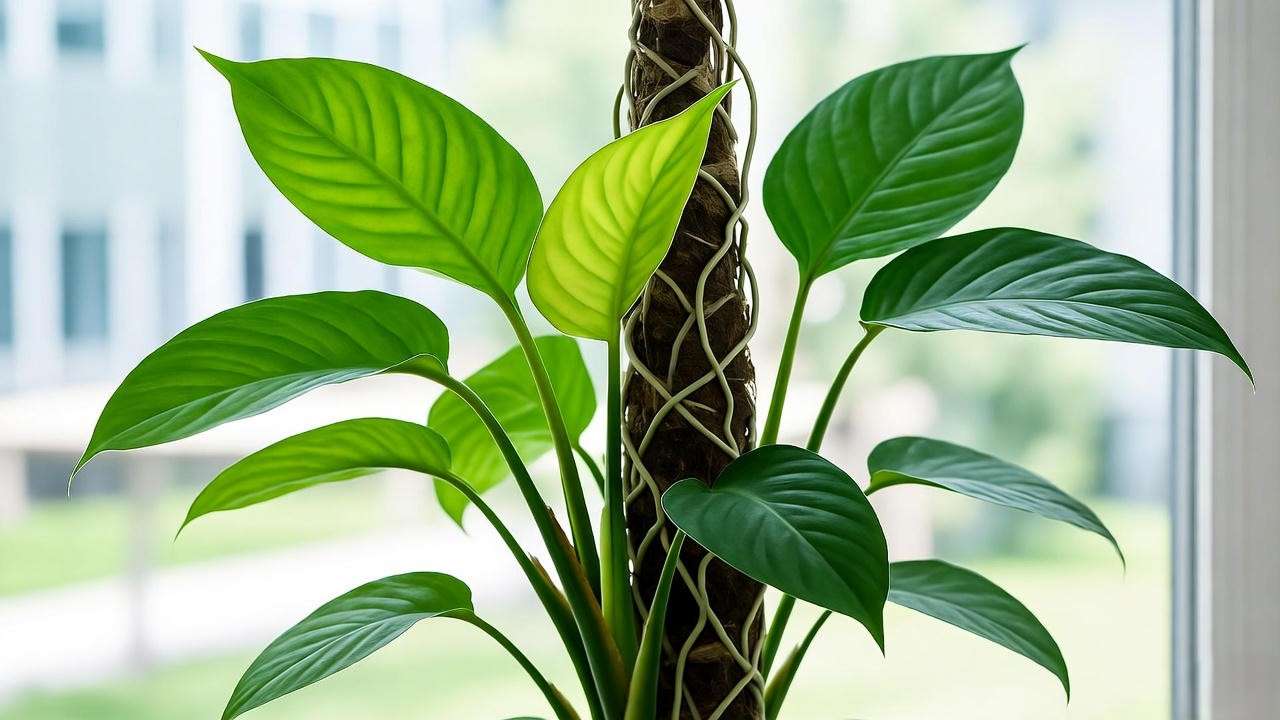
H3: Prevention Strategies: The Importance of Quarantine.
Always quarantine any new plant for 2-4 weeks before introducing it to your collection. This prevents a potential infestation from spreading.
D. Loss of Variegation: Why the ‘White’ is Turning Green
When the White Butterfly Plant reverts and starts producing entirely green leaves, it’s a critical cry for help.
- The Role of Light in Maintaining White Coloration: White portions of the leaf lack chlorophyll, the green pigment used for photosynthesis. To support the less efficient white parts, the plant needs more light overall. If light is low, the plant shifts its energy into making more chlorophyll (green) to survive, sacrificing the white variegation.
- Selective Pruning: Removing Full Green Runners to Preserve Variegation: If a vine produces a solid green leaf, prune it off immediately. Green growth is stronger, grows faster, and will eventually take over and outcompete the variegated sections of the plant.
V. Propagation & Repotting: Expanding Your Syngonium Collection ✂️🌱
The White Butterfly Plant is one of the most rewarding houseplants to propagate. Not only is it easy, but it’s the best way to recycle pruned cuttings and ensure you always have a backup plant or a gift for a friend.
A. Propagation Perfection: Cloning Your White Butterfly Plant
H3: Simple Stem Cuttings: Finding the Node and Preparing the Cutting.
The key to successful Syngonium propagation is identifying the node. A node is the slightly swollen joint on the stem where a leaf attaches and where an aerial root often emerges. This is where the plant’s growth hormones are concentrated.
- Select the Stem: Choose a healthy, non-flowering stem with at least two or three leaves.
- Make the Cut: Using clean, sharp scissors or pruners, make a cut about a quarter-inch below a node.
- Ensure Success: The cutting should have at least one leaf (to collect energy) and at least one node (to grow roots).
H3: Water vs. Soil Propagation: Pros and Cons of Each Method.
| Method | Pros | Cons | Expert Recommendation |
| Water | Easy to monitor root growth; visually appealing. | Roots are brittle and sensitive; high risk of transition shock. | Best for visual learners or short-term root initiation. |
| Soil | Less chance of shock; roots adapt immediately to the permanent medium. | Harder to monitor progress; soil must stay lightly moist. | Recommended for long-term health and faster acclimation. |
If choosing the soil method, place the cut node into a small pot filled with a damp, airy mix (like the one detailed in Section III C), cover it lightly with a plastic bag or dome to create high humidity, and place it in bright, indirect light.
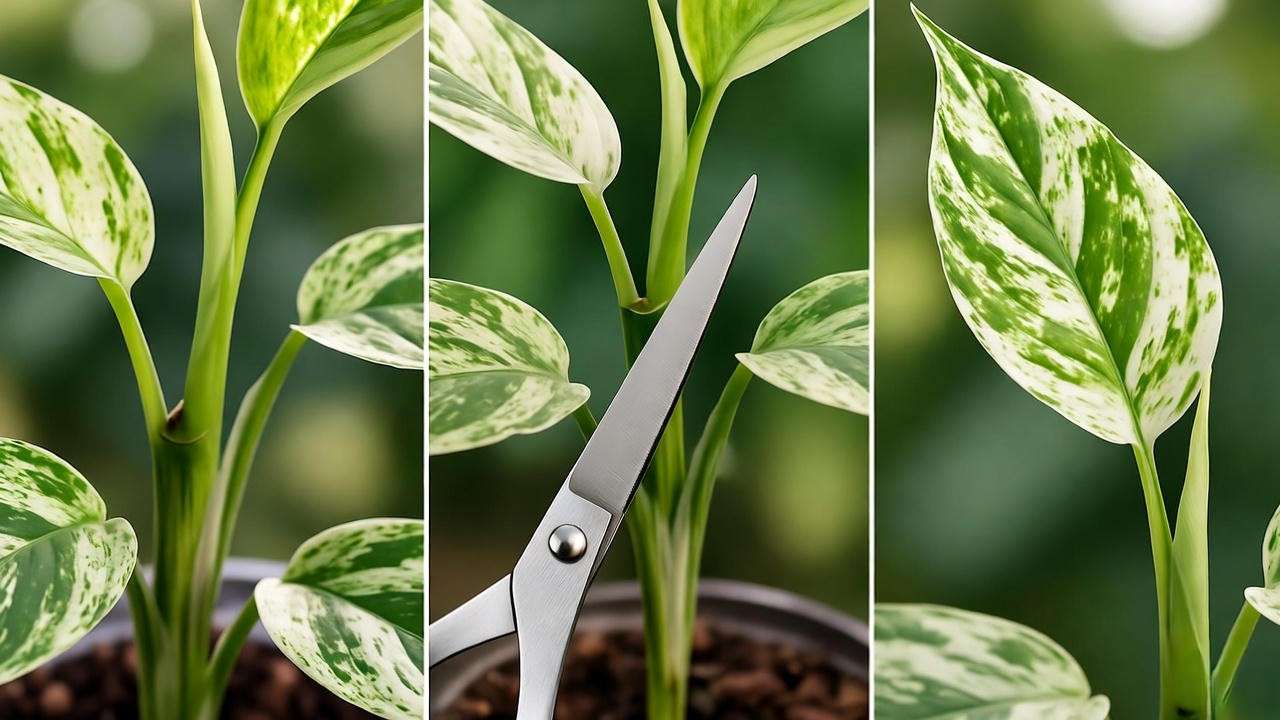
H3: Transition Shock: Successfully Moving Water Cuttings to Soil.
If you root cuttings in water, they develop “water roots,” which are structurally different from the roots needed to take up nutrients in soil. When transplanting:
- Wait until the roots are at least 2 inches long.
- Harden Off: Gradually introduce the cutting to lower humidity and more airflow over a week.
- Plant Gently: Use a very well-draining soil mix and keep the soil slightly wetter than normal for the first two weeks to ease the transition.
B. Repotting Protocol & Root Health
Repotting is essential maintenance, but doing it too often or using the wrong size pot can stress the plant.
H3: When to Repot: Signs Your Syngonium is Rootbound.
Your White Butterfly Plant generally needs repotting every 12 to 18 months. Signs include:
- Roots Circling: Roots are visibly spiraling around the edge of the soil ball when you slide it out of the pot.
- Rapid Drying: The plant requires watering much more frequently than it used to.
- Roots Protruding: Roots are growing out of the drainage holes.
- Stunted Growth: Growth slows significantly during the active growing season.
H3: Choosing the Right Size Pot (Avoid Oversizing).
Never jump more than one pot size up (e.g., from a 6-inch to an 8-inch pot). A pot that is too large holds an excessive volume of soil, which retains too much moisture. This greatly increases the risk of the dreaded root rot.
H3: The Repotting Process: Gently Detangling Roots & Adding Fresh Soil.
- Loosen the Roots: Gently massage the root ball to loosen any circling roots. If they are very tight, you can make a few shallow vertical cuts into the root ball with a clean knife.
- Add Fresh Mix: Place a layer of your prepared, well-draining soil mix into the new pot.
- Position and Fill: Center the plant, ensuring the soil line is the same as it was in the old pot, and fill in around the sides.
- Post-Repotting Care: Wait 3–5 days before watering to allow any nicked roots to heal. Keep the plant in the same bright location, but avoid fertilizing for a month.
VI. Expert Insights & Safety Considerations (E-E-A-T Boost) ⚠️
True expertise includes knowledge of safety and advanced care principles.
A. Toxicity Warning: Pet and Child Safety
H3: The Danger of Calcium Oxalate Crystals (What Happens if Ingested).
Like many plants in the Araceae family, the White Butterfly Plant is toxic if ingested by humans or pets (dogs, cats). It contains insoluble calcium oxalate crystals. When chewed, these microscopic, sharp crystals embed themselves in the mouth and throat tissue.
- Symptoms: Intense pain, swelling, burning sensation, excessive drooling, and vomiting.
- Action: While rarely fatal, contact a veterinarian or poison control immediately if ingestion is suspected.
H3: Placement Strategies: How to Keep the Plant Out of Reach.
The easiest way to mitigate risk is through strategic placement. Utilize high shelves, hanging planters, or plant stands that are inaccessible to curious pets and children.
B. Advanced Care Summary Table (Quick Reference)
| Condition | Ideal Range | Troubleshooting Sign | Expert Solution |
| Light | Bright, Indirect | Green/Losing White | Move closer to a window (South or West, blocked). |
| Water | Top 2-3″ dry | Droopy, Yellowed Leaves | Check drainage; Water thoroughly, then wait. |
| Humidity | $>60\%$ | Crispy leaf tips | Group plants or use a dedicated humidifier. |
| Fertilizer | Monthly (Spring/Summer) | Brown leaf edges (Burn) | Flush the soil and use fertilizer at half-strength only. |
C. Pro Tips for Maximizing White Leaf Coloration
The ‘White Butterfly’ cultivar is prized for its variegation, and optimizing it is a mark of true plant mastery.
H3: The Light-Fertilizer Balance that Fuels the White Pigment.
White leaf sections cannot photosynthesize, making the green sections work harder.
- Maximize Light: This is non-negotiable. Without bright light, the plant conserves energy by reverting to green.
- Balanced Feeding: Regular, light fertilization ensures the plant has enough energy to maintain the white sections without the need to overproduce chlorophyll. Think of the fertilizer as high-octane fuel for the green parts supporting the white.
H3: Regular Dusting: Ensuring Leaves Can Absorb Maximum Light.
Dust on the large, flat leaves of the Syngonium can block up to 50% of available light over time. Once a month, gently wipe down the upper and lower surfaces of the leaves with a damp cloth. This is a simple step that significantly impacts the plant’s overall health and ability to utilize light efficiently.
VII. Frequently Asked Questions (FAQs) ❓
Addressing these common questions helps capture relevant long-tail search traffic and provides immediate answers to audience needs.
H3: How Fast Does a White Butterfly Plant Grow?
Under ideal conditions (bright light, high humidity, regular feeding during the active season), the White Butterfly Plant is considered a fast grower. It can put out several new leaves or extend its vines by several feet in a single growing season. Growth will slow considerably in the winter.
H3: Can I Put My White Butterfly Plant Outdoors?
Yes, but only in the summer and only if you live in a tropical climate (USDA zones 10-12). If your area is cooler, you can move it outdoors in the summer once nighttime temperatures consistently stay above $60^\circ\text{F}$ ($16^\circ\text{C}$). Always place it in a shaded area—never direct sun—to prevent immediate, severe sunburn. Bring it indoors well before the first cool spell.
H3: Do I need to give it a dormant period?
While it doesn’t enter a true deciduous dormancy like some plants, its growth naturally slows in the late fall and winter due to shorter days and lower light intensity. This is the time to reduce watering frequency and stop fertilizing completely. This period of rest is beneficial for the plant’s long-term health.
H3: Is the White Butterfly Plant rare?
No, the ‘White Butterfly’ cultivar of Syngonium podophyllum is one of the most common and widely available houseplants due to its hardiness and ease of propagation. There are, however, many other, much rarer Syngonium cultivars (like the ‘Pink Splash’ or ‘Three Kings’) that command higher prices.
VIII. Conclusion: Enjoying Your Thriving White Butterfly Plant 🥳
You are now armed with the comprehensive knowledge of an experienced plant expert. The days of struggling with your White Butterfly Plant are over, replaced by the simple, rewarding routine of watching it flourish.
Remember the three pillars of Syngonium success:
- Bright, Indirect Light to fuel that beautiful white variegation.
- Meticulous Watering where you wait for the top few inches to dry.
- Proactive Troubleshooting to address humidity, pests, and leggy growth before they become crises.
This plant is resilient and forgiving. By consistently applying the techniques outlined in this skyscraper guide, you will unlock the natural beauty of the White Butterfly Plant, transforming it from a frustrating challenge into a thriving centerpiece of your collection.

